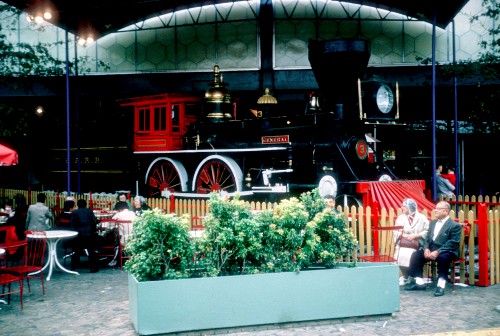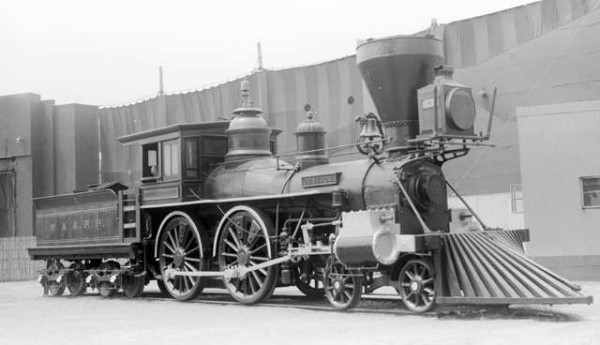|
Those who didn't want to
venture inside the Better Living Center to see several floors
of exhibits before leaving could still see its largest exhibit
situated just outside the building, an authentic Civil War locomotive
called the General which had been a staple of major World's
Fairs held in America as far back as 1893 and which had a fascinating
history behind it.
-
The
General on display at the Better Living Center during
the 1964 Season of the New York World's Fair
SOURCE: Photo
presented courtesy Bill Cotter collection © 2010 Bill Cotter,
All Rights Reserved. See more images from Bill's fabulous
collection of World's Fair photographs at his website WorldsFairPhotos.com.
 |
On April 12, 1862 a group
of twenty Union raiders led by a civilian spy, James J. Andrews,
stole the General from its station in Marietta, Georgia
as part of a daring attempt to destroy Confederate rail and telegraph
lines throughout the state and disrupt rail service between Atlanta
and Chattanooga. The ensuing chase of the General by the
pursuing locomotive Texas ended when the General
ran out of steam eighteen miles below Chattanooga. All of the
raiders were captured with eight of them eventually hanged, including
Andrews. The rest managed to escape imprisonment or were later
exchanged during the war for Confederate prisoners. After the
release of the remaining six raiders, Secretary of War Edwin
Stanton made the raiders the first recipients of the Congressional
Medal Of Honor (save for Andrews who, as a civilian, was not
eligible) in recognition of the courage they had demonstrated
in such a difficult operation.
While the "Great Locomotive
Chase" earned itself a permanent place in Civil War folklore,
the General itself returned to nearly thirty more years
of obscure service for the Western & Atlantic Railway Company,
eventually falling into a state of near-ruin and being described
as "condemned" when retired from service. The decaying
locomotive was located by a photographer/lecturer, E. Warren
Clark, in Vinings, Georgia. He hit upon the idea of restoring
the locomotive and having it put on display at the 1893 World's
Columbian Exposition in Chicago where it proved to be a successful
attraction from an attendance standpoint (though not from a financial
standpoint for Clark, who went broke from the endeavor).
After its display in Chicago
the General spent most of the next sixty years on display
in Chattanooga, being moved for exhibit to Baltimore in 1927,
again to Chicago in 1933 for the Century of Progress Exposition
and to New York for the 1939-1940 World's Fair. After World War
II the locomotive became the subject of a drawn-out dispute between
Tennessee and Georgia over where it would be permanently displayed
and these matters were still ongoing in the early 1960s when
the General underwent a new restoration that enabled it
to move under its own power once again. A national tour followed
during the celebration of the Civil War centennial and, in 1964,
it was decided to bring the locomotive to the second New York
World's Fair. Because of a tour commitment in Louisville during
Derby Week, the General wouldn't arrive at the Fair until
more than a month after opening day.
The General
on display at the 1939-1940 New York World's Fair
SOURCE: From
WIKIPEDIA (http://en.wikipedia.org/wiki/The_General_(locomotive)),
: This image (call number OP-19817) is from the collection
of the photographs of the late Otto Perry (b.1894, d.1970) held
at the Western History Department of the Denver Public Library
(http://photoswest.org/),
and is copyrighted. The department actively encourages fair use
of its images for educational purposes.
 |
After being transported
to New York by railroad ferry her engine was fired up and the
General traveled to Flushing Meadow under her own power along
the Long Island Railroad tracks and entered its exhibit location
at the Better Living Center by means of a special track that
was laid. The General carried behind it a special "museum
coach" filled with numerous railroad memorabilia that would
also be a part of the display.
Because of the difficulties
in keeping the General over the winter months at the Fairgrounds
the locomotive was only displayed at the Fair during the 1964
season and then returned to its traditional berth in Chattanooga.
The locomotive would only travel under its own steam again one
more time before finally moving to a permanent home in Georgia
(after a Supreme Court ruling finally settled the matter of ownership)
at the Kennesaw Civil War Museum where it has been displayed
continuously since 1972.
The General's presence
at a World's Fair that also featured an original copy
of the Gettysburg Address in the Illinois Pavilion certainly made Flushing Meadows
"the place to be" for serious Civil War buffs in 1964!
To learn more about the
story of "The Great Locomotive Chase" visit the Kennesaw
Museum's site at http://www.locomotivegeneral.com/general.html.
|